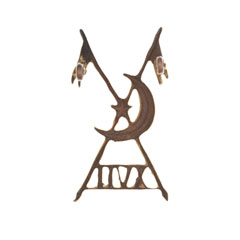
Online Collection
Cap badge, 17th Cavalry, 1903-1922
Brass badge in the form of a crescent and star at the intersection of crossed lances, with the regimental number, in open-work Roman numerals, 'XVII', below.
The 17th Cavalry was first raised in 1857 as the Muttrah Horse. Its titles included Muttrah Police Corps (1857-1858), Rohilkhand Auxiliary Police Levy (1858-1859), and then Robart's Horse (1859-1861), before settling as the 17th Regiment of Bengal Cavalry (1861-1882, and 1885-1901). It was briefly known as the 17th Bengal Lancers in 1901 before being renamed as the 17th Cavalry under Lord Kitchener's Indian Army reforms that were completed in 1903.
The regiment arrived in Allahabad at the beginning of 1914, consisting of two squadrons of Punjabi Muslamans, and two squadrons of Pathans. Most of the regiment spent World War One (1914-1918) in India, with detachments at Jhansi, Calcutta, Lahore and Jullundar, however, in 1915 one Pathan squadron was detached for service in East Africa, spending two years in that theatre. By the signing of the Armistice on 11 November 1918, the majority of the regiment had reassembled at Lahore.
In 1919, the regiment was deployed to the 3rd Afghan War and earned the battle honour 'Afghanistan 1919'. In 1921, it amalgamated with 37th Lancers (Baluch Horse) to form 17th/37th Lancers but this combined regiment was renamed the 15th Lancers in 1922.
From the Field Marshal Sir John Chapple Indian Army Collection.
NAM Accession Number
NAM. 2013-10-20-16-9
Copyright/Ownership
National Army Museum Copyright
Location
National Army Museum, Study collection
Object URL
https://collection.nam.ac.uk/detail.php?acc=2013-10-20-16-9


